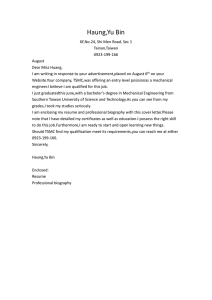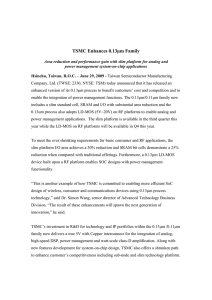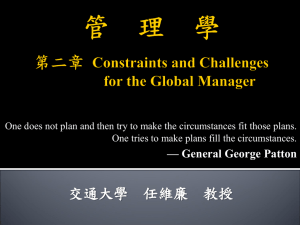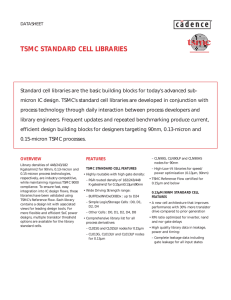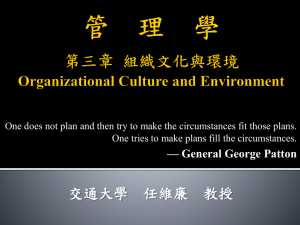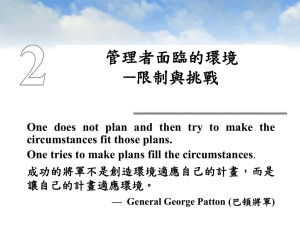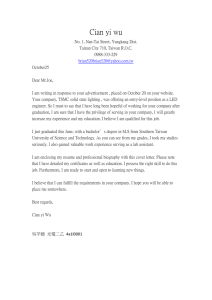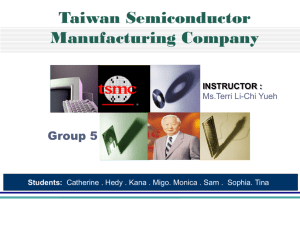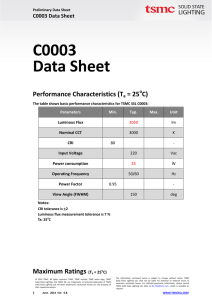url - TSMC
advertisement
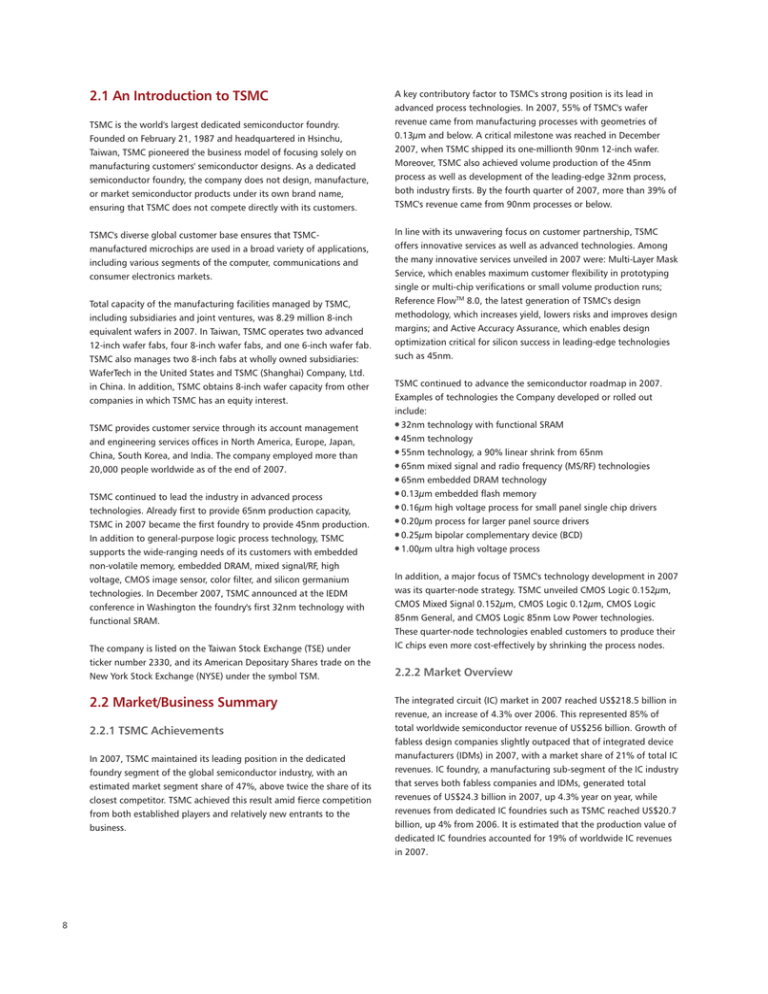
2.1 An Introduction to TSMC TSMC is the world's largest dedicated semiconductor foundry. Founded on February 21, 1987 and headquartered in Hsinchu, Taiwan, TSMC pioneered the business model of focusing solely on manufacturing customers' semiconductor designs. As a dedicated semiconductor foundry, the company does not design, manufacture, or market semiconductor products under its own brand name, ensuring that TSMC does not compete directly with its customers. TSMC's diverse global customer base ensures that TSMCmanufactured microchips are used in a broad variety of applications, including various segments of the computer, communications and consumer electronics markets. Total capacity of the manufacturing facilities managed by TSMC, including subsidiaries and joint ventures, was 8.29 million 8-inch equivalent wafers in 2007. In Taiwan, TSMC operates two advanced 12-inch wafer fabs, four 8-inch wafer fabs, and one 6-inch wafer fab. TSMC also manages two 8-inch fabs at wholly owned subsidiaries: WaferTech in the United States and TSMC (Shanghai) Company, Ltd. in China. In addition, TSMC obtains 8-inch wafer capacity from other companies in which TSMC has an equity interest. TSMC provides customer service through its account management and engineering services offices in North America, Europe, Japan, China, South Korea, and India. The company employed more than 20,000 people worldwide as of the end of 2007. TSMC continued to lead the industry in advanced process technologies. Already first to provide 65nm production capacity, TSMC in 2007 became the first foundry to provide 45nm production. In addition to general-purpose logic process technology, TSMC supports the wide-ranging needs of its customers with embedded non-volatile memory, embedded DRAM, mixed signal/RF, high voltage, CMOS image sensor, color filter, and silicon germanium technologies. In December 2007, TSMC announced at the IEDM conference in Washington the foundry's first 32nm technology with functional SRAM. The company is listed on the Taiwan Stock Exchange (TSE) under ticker number 2330, and its American Depositary Shares trade on the New York Stock Exchange (NYSE) under the symbol TSM. 2.2 Market/Business Summary 2.2.1 TSMC Achievements In 2007, TSMC maintained its leading position in the dedicated foundry segment of the global semiconductor industry, with an estimated market segment share of 47%, above twice the share of its closest competitor. TSMC achieved this result amid fierce competition from both established players and relatively new entrants to the business. 8 A key contributory factor to TSMC's strong position is its lead in advanced process technologies. In 2007, 55% of TSMC's wafer revenue came from manufacturing processes with geometries of 0.13µm and below. A critical milestone was reached in December 2007, when TSMC shipped its one-millionth 90nm 12-inch wafer. Moreover, TSMC also achieved volume production of the 45nm process as well as development of the leading-edge 32nm process, both industry firsts. By the fourth quarter of 2007, more than 39% of TSMC's revenue came from 90nm processes or below. In line with its unwavering focus on customer partnership, TSMC offers innovative services as well as advanced technologies. Among the many innovative services unveiled in 2007 were: Multi-Layer Mask Service, which enables maximum customer flexibility in prototyping single or multi-chip verifications or small volume production runs; Reference FlowTM 8.0, the latest generation of TSMC's design methodology, which increases yield, lowers risks and improves design margins; and Active Accuracy Assurance, which enables design optimization critical for silicon success in leading-edge technologies such as 45nm. TSMC continued to advance the semiconductor roadmap in 2007. Examples of technologies the Company developed or rolled out include: 32nm technology with functional SRAM 45nm technology ● 55nm technology, a 90% linear shrink from 65nm ● 65nm mixed signal and radio frequency (MS/RF) technologies ● 65nm embedded DRAM technology ● 0.13µm embedded flash memory ● 0.16µm high voltage process for small panel single chip drivers ● 0.20µm process for larger panel source drivers ● 0.25µm bipolar complementary device (BCD) ● 1.00µm ultra high voltage process ● ● In addition, a major focus of TSMC's technology development in 2007 was its quarter-node strategy. TSMC unveiled CMOS Logic 0.152µm, CMOS Mixed Signal 0.152µm, CMOS Logic 0.12µm, CMOS Logic 85nm General, and CMOS Logic 85nm Low Power technologies. These quarter-node technologies enabled customers to produce their IC chips even more cost-effectively by shrinking the process nodes. 2.2.2 Market Overview The integrated circuit (IC) market in 2007 reached US$218.5 billion in revenue, an increase of 4.3% over 2006. This represented 85% of total worldwide semiconductor revenue of US$256 billion. Growth of fabless design companies slightly outpaced that of integrated device manufacturers (IDMs) in 2007, with a market share of 21% of total IC revenues. IC foundry, a manufacturing sub-segment of the IC industry that serves both fabless companies and IDMs, generated total revenues of US$24.3 billion in 2007, up 4.3% year on year, while revenues from dedicated IC foundries such as TSMC reached US$20.7 billion, up 4% from 2006. It is estimated that the production value of dedicated IC foundries accounted for 19% of worldwide IC revenues in 2007.
